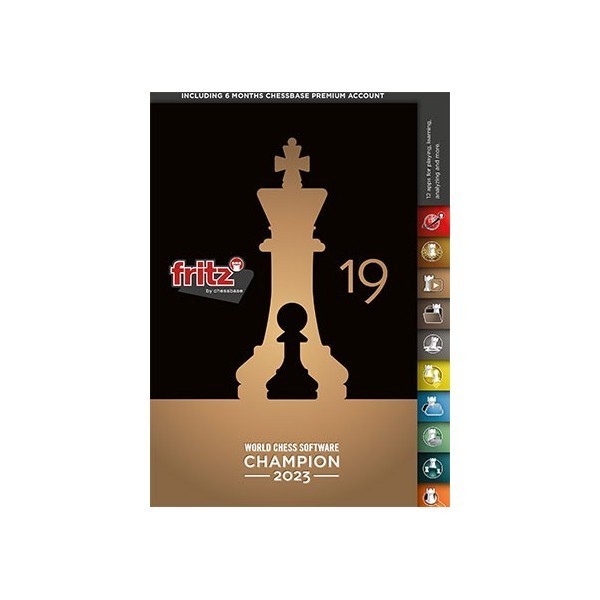Fritz 19
Whether your opponent is an attacking player, a coward, a con artist, or an endgame magician… Fritz 19 shows you how to win!
Languages: English, German, French, Spanish, Italian
System: Windows 10 or higher
Fritz 18 marked the beginning of a new era, and Fritz 19 continues this evolution: a game against Fritz is more than just a game – it’s a unique experience! In an age where online chess dominates, a chess program must offer something special to be a true alternative to human opponents.
With Fritz 19 it works as follows:
-
There are six different characters that mimic typical club players: Versatile, Aggressive, Positional, Scammer, Timid, Endgame Expert.
-
Fritz plays human moves that fit these types, but incorporates tactical errors so you can win with an attack tied to a sacrifice, for example. The more tense the position, the more likely the program is to make mistakes.
-
There are a wide range of tips and aids that you can use to their fullest or ignore—depending on your mood. With all the tips, you'll almost always win against the "strong club player" level. If you ignore them completely, it becomes a challenge for a player like someone under 2000 Elo.
-
You can earn trophies for specific moves that are converted into digital trading cards, such as " 7th rank ♖ ," "quality sacrifice," or "mate threat."
-
At any point during the game, you can switch to "assisted calculation" mode. There is no clock, allowing you to practice your calculations without stress.
The collection of opponents
The all-rounder is probably the strongest opponent at all levels of play. This is an evolution of Fritz 18's "Easy Game."
-
-
Everyone knows an aggressive player at their club. He regularly plays an all-out attack, with a sharp opening repertoire. He's the ideal opponent to practice defense with as Black.
-
The scammer pushes aggression to the extreme and often overplays his position. Against this cunning fox, you usually have a material advantage, but it suddenly becomes very dangerous. Material and a solid position are of no use against him; the main thing is to tease his ♔ .
-
The wise owl symbolizes the positional player. He likes a good ♙ structure, a safe ♔ , and coordinated piece play.
-
The fearful mouse is a distorted echo of this. It likes cluttered, safe positions and is afraid of complications. This is why it often plays more weakly.
-
The endgame enthusiast, on the other hand, plays specifically for a maximum exchange. Simplification is paramount for him, and his opening is most often unambitious. However, in the endgame, things get tougher. This is an effective training opponent for this phase of the game!
-
Practice games against Fritz even more entertaining
Playing against Fritz 19, you can obtain 136 different trophies. Some are quite simple, such as:
Closed center, or
Pair of ♗ ♝
You'll get them quickly. Others don't come by themselves:
Advance of a past ♙
Outpost for the ♘
Precarious position of the opposing ♚
Space advantage, or even
Sharp position
Trophies such as:
Sacrifice of ♕
Mate with the ♘
and many more, constitute the crowning glory. There is a ranking list for each of these trophies. This might have been reward enough, but we came up with something very special, the description of which would go beyond the scope of this article: the trophies won are rewarded with the distribution of digital trading cards in your ChessBase account. Remember Panini sticker albums? Then you know what they are.
New Method to Train Your Opening Repertoire
We all manage our opening repertoire in variation trees stored in databases. If you want to play against this repertoire, it becomes technical: opening books must be converted. With today's powerful computers, this has become obsolete. In Fritz 19, you play directly against databases, your own repertoire, or an opening article from ChessBase magazine!
If the White player, the Black player, the tournament title, or the source begins with "White" or "Black," all moves in this game belong to that color. Fritz will therefore only play these moves. A repertoire is always rather narrow in terms of its own color and broad in terms of the opponent's moves. For example, try your Najdorf repertoire with Black against the "aggressive" player! Tip for ChessBase users: Save an opening study generated by ChessBase and play against it immediately.
Please note: The link will be sent by email after payment.





































